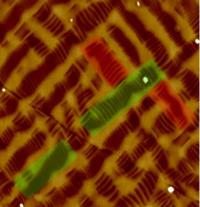A research team at the U.S. Department of Energy (DOE) Lawrence Berkeley Lab has increased natural magnetization in special versions of the multiferroic bismuth ferrite.
 Berkeley's atomic force microscopy topography
Berkeley's atomic force microscopy topography
The magnetization can be turned on or off with an outside electric field essential for spintronic technology.
The magnetic state can electrically monitor this magnetism at room temperature, states Ramamoorthy Ramesh, a materials scientist at Berkeley Lab's Materials Sciences Division, who led the team. Increased magnetization occurs in the rhombohedral stages of bismuth ferrite nanostructures. This is contained by pressure between the tetragonal stages of the material. It can be removed with an electric field. It is reinstated when the electric field polarity is reversed.
Ramesh has co-authored the paper titled, ‘Electrically Controllable Spontaneous Magnetism in Nanoscale Mixed Phase Multiferroics,’ published in the journal, Nature Communications.
Multiferroics can exhibit both electric and magnetic characteristics. Bismuth ferrite is an insulator. But its two dimensional layers called ‘domain walls’ conduct electricity. By applying an epitaxial pressure or compression in the direction of crystal stages, alters the crystal form from the rhombohedral to a tetragonal phase. When the pressure is relaxed, it causes a constant nanoscale mixture of the rhombohedral and tetragonal stages. The magnetic elements created naturally in these films exist in the rhombohedral phase.
Source: http://www.lbl.gov/